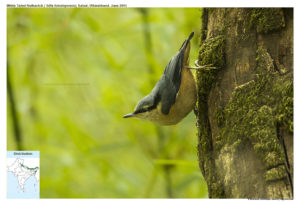
White-tailed Nuthatch Sitta himalayensis
Etymology:
- Sitta : Greek word for a bird like a woodpecker
- Himalayensis : From Himalayan Mountains
Vernacular Names: Lepcha: Siddyi-phip
Distribution in India: Resident of Himalayas in India
Description: Size of 12 cm; 11–17 g. It is a small, dumpy, relatively short-billed nuthatch. The male in fresh plumage (Sept–Apr) has crown to rump as dull blue-grey, sometimes crown and especially nape and upper mantle are slightly paler; forehead, lores and eyestripe are sooty black, expanding broadly on to side of upper mantle, sometimes an indistinct narrow grey-white supercilium just above and behind eye. The upperwing is dark grey-brown, wing-coverts are fringed blue-grey, extensively so on outer web of greater coverts, alula is fringed blue-grey on outer web, tertials are medium grey ,tinged blue on outer web, secondaries are broadly fringed blue-grey, primaries are finely fringed light grey, pale fringes progressively restricted to base of feather towards outer wing; central tail feathers are dull blue-grey, slightly darker and greyer along shaft and at tip, basal half of outer web adjacent to shaft is white, basal two-thirds of inner web is white, other rectrices are sooty black, outermost with white diagonal stripe sub-terminally across feather, next to outermost is with large white sub-terminal spot on inner web. The chin, cheek and throat are whitish, variably washed buff, grading into cinnamon-orange on upper and rear ear-coverts, upper flanks and breast, and darker and richer orange-cinnamon on belly and flanks to undertail-coverts. The axillaries are grey-buff, underwing-coverts are sooty black, base of under primaries and secondaries are white. In worn plumage, a whitish feather bases may show on nape and upper mantle, black eyestripe more extensive, especially at rear, wings are darker and sootier, underparts are paler and whiter, buff-white on breast and belly. The iris is brown; bill is black or blackish-brown, base of lower mandible is bluish-white or grey; legs are dark brown, dark greenish-brown or dark yellowish-brown, soles are greyish-white. The female is as male, but ear-coverts and underparts on average are slightly paler and duller. The juvenile resembles the adult.
Habitat: It is found in broadleaf and mixed forests, oak and rhododendron forests, mossy forest, mixed forests of fir, hemlock and maple. It is found from 950 m to 2800 m.
Food habits: It eats insects, also nuts and seeds. It forages on mossy branches, usually in upper parts of trees, less frequently on trunk and occasionally in low shrubs.
Breeding habits: They breed in Mar to May in Indian Subcontinent, and Myanmar. The nest is built by female, male providing material. The nest is a pad of green moss, mossy fibers and rhododendron leaves, placed above ground in tree cavity, usually in oak. The hole if too large may be “plastered” up with mixture of mud and berries. They lay a clutch of 4–7 eggs. The incubation of eggs and feeding of chicks are done by both sexes.